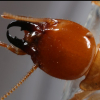It's time for some more termites, and for today's episode we have a species possessing several peculiar and interesting characteristics: Prorhinotermes simplex.
This species is often known as the "cuban subterrean termite" in the US and hails for a quite small areale, being restricted to eastern Cuba, Jamainca, Puerto rico and southeastern Florida, all of which have it as a native animal. Of the 20 Prorhinotermes species (which have the greater diversity in Indo-Malaysia, with 11 species from that region alone) only 3 are know from the new world, simplex being by far the most notorious of the trio. These termites nests inside humid wood, but unlike the species usually referred to as "damp/drywood" termites (like Neotermes, Zootermopsis, Cryptotermes, Incisitermes and many others) which exclusively reside inside the wood hosting them never leaving it, they often move and forage in (and outside, since they also build shelter tubes) the soil, which qualify them as a subterrean genus. When the piece of wood they are inhabiting becomes too depleted, the whole colony moves to another one. The location of this genus' colonies is also peculiar: they are associated with water, usually brackish or marine, and live in coastal areas and swampy mangrove habitats, which are quite unhospital for other termites. They are rarely fond inland. P. simplex itself is quite adaptable, and can be found nesting near fresh, brackish or salt water. These quite small colonies are guarded by an exceptional percentage of soldiers: up to 22% in simplex, while in other species like P. inopinatus they can account for a whopping full quarter of the colony! Despite several nasute termites can reach and surpass these numbers, such large percentage of soldiers is truly remarkable for mandibulated species like Prorhinotermes. Since these numerous soldiers are also equipped with a very effective chemical secretion to back up their mandibles, Prorhinotermes colonies are indeed well protected. They are generally not considered pests by humans.
P. simplex have several castes: primary and neotenic royals, pseudergates (all Prorhinotermes lacks a true worker castes) and soldiers.
As is the norm, the primaries are well sclerotized, sport large compound eyes and mature with wings from a padded nymphal line, all tracts that will allow them to partecipate in a swarming event to found new colonies, just like in other termites. After a male and a female pairs up they quickly search for a safe place to mate and start their new lives as king and queen.
Pseudergates, which moult troughout all their lives, act exactly like workers proper: they mantain and expand the nest, forage and care for other castes and the brood, however they also retain a high developmental plasticity, allowing them to moult into other castes should the need arise. These also includes ergatoid neotenics, so if a number of pseudergates get separated from their parent colony they're not condemned to die off, but a some of them will moult into neotenic secondary royals and start breeding. In this regards Prorhinotermes seems capable of succesfully generating viable colonies from a very small number of pseudergates, less than those required by other species.
The soldiers are without a doubt the most interesting caste of the bunch: as said before, they are present in truly impressive percentages for a mandibulated species, and possess a potent and toxic defensive secretion that they store in their bodies and exude from a tiny fontanelle, visible as a very small pore on the top of the head. This clear liquid is produced in small quantities but is highly toxic to their foes, in primis ants and other termites. It backs up a pair of slashing-type mandibles designed to cut, and contains unusual chemicals like the nitropentadecene, which make a soldier's bite very dangerous for would-be predators. They are very abundant in the nest peripheries and always accompany the foraging workes in number; they also vary slightly in size among a given colony, but lack true forms like minors and majors. It's in Prorhinotermes simplex soldiers that an unique behaviour have been reported: the removal of eggs from dangerous areas. In the case of a nest breach in which eggs are scattered in the open, they have been observed to grasp the stranded eggs and then pass them to pseudergates, often waiting at the nest entrances. Despite their enlarged mandibles are quite in the way when picking up eggs, this is a truly remarkable behaviour for termite soldiers, that usually fight and nothing else due to their extreme morphological and behavioural specialization. May this egg-rescuing be better allowed (and hence adopted) thanks to the level of protection their powerful chemical secretion provides?
And now some shots, all courtesy of doctor Jan Sobotnik, form the Czech University of Life Sciences of Prague!

A soldier and a pair of pseudergates of Prorhinotermes simplex. The soldier is easily recognizable from its thicker tegument, armored head and black, elongated and sharp mandibles. Also note its fontanelle, that small pore on his head, and the fine groove that allow its toxic secretion to descend toward the mandibles and be better administered with a bite.

Here we have a clear shot of a presoldier, a transitional form present in all termites that will soon moult to become a full-fledged soldier. Despite this Prorhinotermes simplex is still soft and mostly inactive, and lack both the instinct and capabilities of a mature soldier, its future morphology is already evident.

A royal of an incipient captive colony grooming an egg: theese are frequently licked, cleaned and moved by their caretakers. You can even see the deveoping termites inside.

Here a soldier show us its unique egg-rescuing behaviour: we can see it encountering and identifying a clutch of stranded eggs (1), picking them up with its palps (2,3) and returning them to a nest opening (4). There it will try to pass them to a pseudergate.
So, here's some Prorhinotermes simplex for you folks. To the next termite!
















